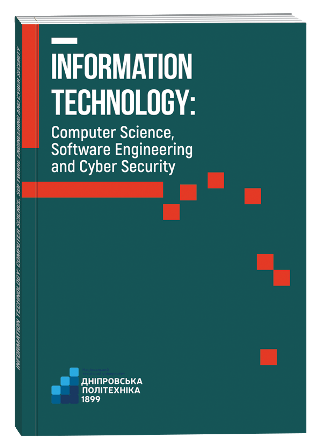RECOGNITION AND MONITORING OF WATER OBJECTS ON OPTICAL SATELLITE IMAGES USING MACHINE LEARNING
DOI:
https://doi.org/10.32782/IT/2023-3-4Keywords:
machine learning, image segmentation, mapping, coastline digitization, support vectors.Abstract
Rivers, lakes, and open water objects are important components of environmental development, especially in urban ecosystems. Accurate maps of urban surface water objects based on satellite data are an essential prerequisite for better and faster decision-making in monitoring urban ecosystems, the impact of urban heat islands, and climate change adaptation. The paper introduces an information technology for recognition and monitoring of water objects on optical satellite images using machine learning. The developed technology consists of eight steps: downloading primary data; georeferencing of raster images; data preprocessing; data segmentation to determine the boundaries between land and water; digitizing the coastline; creating a binary mask; mapping the contours of water bodies using a topographic map; and analyzing spatial and temporal changes. Machine learning is used for image segmentation, and support vector machine (SVM) is used for water body contour mapping. The result is sub-pixel accuracy, providing relevant information for further research and decision-making. The experiments were conducted on Sentinel-2 data for monitoring water bodies with a spatial resolution of 10 meters. The subject area was the coastline of the Odesa region – the Tuzly Estuaries National Nature Park. Comparative quantitative analysis with existing methods, such as water indices and K-means, confirms the high accuracy of the developed technology during 2016-2023 (accuracy from 96.96% to 97%). The Kappa coefficient, representing the degree of consistency between the actual and predicted classification, confirms the high stability and reliability of the approach (0.94). The water objects monitoring technology on optical satellite images using machine learning has the potential to be used to study changes in coastal areas and to make decisions in the field of coastal resource and land use management.
References
Chatufale, Aditya P., Priti, P. Rege, and Abhishek Bhatt. Extraction of waterbody using object-based image analysis and XGBoost. Advanced Machine Intelligence and Signal Processing. Singapore: Springer Nature Singapore, 2022. 341-350.
Chen, Y., Fan, R., Bilal, M., Yang, X., Wang, J., Li, W. Multilevel Cloud Detection for High-Resolution Remote Sensing Imagery Using Multiple Convolutional Neural Networks. ISPRS Int. J. Geo-Inf., 7, 2018. 181.
Désirée, Ruppen, James, Runnalls, Raphael, M., Tshimanga, Bernhard, Wehrli, Daniel, Odermatt. Optical remote sensing of large-scale water pollution in Angola and DR Congo caused by the Catoca mine tailings spill. International Journal of Applied Earth Observation and Geoinformation, 2023. 118.
Feng, W., Sui, H., Huang, W., Xu, C. and An, K. Water Body Extraction From Very High-Resolution Remote Sensing Imagery Using Deep U-Net and a Superpixel-Based Conditional Random Field Model. IEEE Geoscience and Remote Sensing Letters, 2019. 16(4), 618-622.
Fisher, A., Flood, N., Danaher, T. Comparing Landsat water index methods for automated water classification in eastern Australia. Remote Sens. Environ, 2016. 175, 167–182.
Jiang, W., He, G., Long, T., Ni, Y., Liu, H., Peng, Y., Lv, K., Wang G. Multilayer Perceptron Neural Network for Surface Water Extraction in Landsat 8 OLI Satellite Images. Remote Sens, 2018. 10, 755.
Li, W, Qin, Y, Sun, Y, Huang H, Ling F, Tian L, Ding Y. Estimating the relationship between dam water level and surface water area for the Danjiangkou Reservoir using Landsat remote sensing images. Remote Sens Lett, 2016. 7(2), 121–130.
Liu, Qihang, et al. Probabilistic river water mapping from Landsat-8 using the support vector machine method. Remote Sensing, 2020. 12(9), 1374.
Mao, Taomin, Yewen, Fan, Shuang Zhi, and Jinshan, Tang. A Morphological Feature-Oriented Algorithm for Extracting Impervious Surface Areas Obscured by Vegetation in Collaboration with OSM Road Networks in Urban Areas. Remote Sensing, 2022. 10(14), 2493.
Nardini, A.G.C., Salas, F., Carrasco, Z., Valenzuela, N., Rojas, R., Vargas-Baecheler, J., Yépez S. Automatic River Planform Recognition Tested on Chilean Rivers. Water, 2023. 15, 2359.
Palomar-Vázquez, Jesús, Josep E., Pardo-Pascual, Jaime, Almonacid-Caballer, and Carlos, Cabezas-Rabadán. Shoreline Analysis and Extraction Tool (SAET): A New Tool for the Automatic Extraction of Satellite-Derived Shorelines with Subpixel Accuracy. Remote Sensing, 2023. (15), 3198.
Vapnik V. Cham. The Nature of Statistical Learning Theory. Springer Science & Business Media. 2013.
Wangchuk, Sonam, and Tobias, Bolch. Mapping of glacial lakes using Sentinel-1 and Sentinel-2 data and a random forest classifier: Strengths and challenges. Science of Remote Sensing, 2020. 2, 100008.
Xiang, X., Li, Q., Khan, S., & Khalaf, O. I. Urban Water Resource Management for Sustainable Environment Planning Using Artificial Intelligence Techniques. Environmental Impact Assessment Review, 2021. (86), 106515.
Xie, H, Luo, X, Xu, X, Pan, H, Tong, X. Automated Subpixel Surface Water Mapping from Heterogeneous Urban Environments Using Landsat 8 OLI Imagery. Remote Sensing, 2016. 87, 584.
Xie, H., Luo, X., Xu, X., Pan, H., Tong, X. Automated Subpixel Surface Water Mapping from Heterogeneous Urban Environments Using Landsat 8 OLI Imagery. Remote Sens, 2016. 8.
Yang, X., Zhao, S., Qin, X., Zhao, N., Liang, L. Mapping of Urban Surface Water Bodies from Sentinel-2 MSI Imagery at 10 m Resolution via NDWI-Based Image Sharpening. Remote Sens, 2017. 9, 596.
Zhou, Y., Dong, J., Xiao, X., Xiao, T., Yang, Z., Zhao, G., Zou, Z., Qin, Y. Open Surface Water Mapping Algorithms: A Comparison of Water-Related Spectral Indices and Sensors. Water, 2017. 7.







